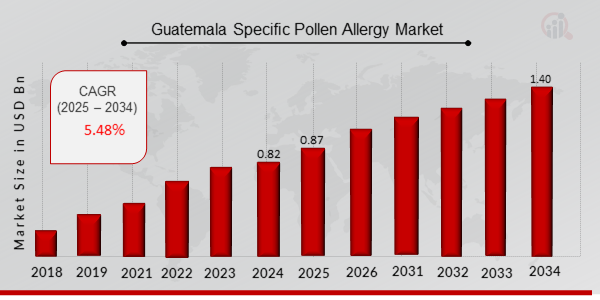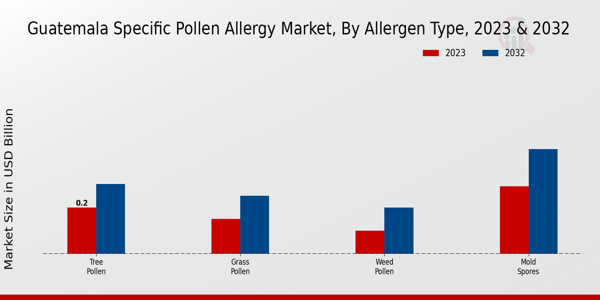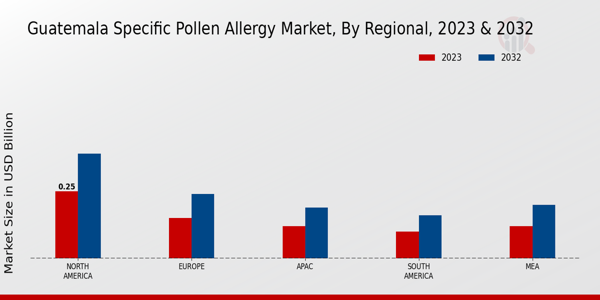Guatemala Specific Pollen Allergy Market Overview
As per MRFR analysis, the Guatemala Specific Pollen Allergy Market Size was estimated at 0.82 (USD Billion) in 2024. The Guatemala Specific Pollen Allergy Market Industry is expected to grow from 0.87 (USD Billion) in 2025 to 1.40 (USD Billion) till 2034, at a CAGR (growth rate) is expected to be around 5.48% during the forecast period (2025 - 2034).
Key Guatemala Specific Pollen Allergy Market Trends Highlighted
The Guatemala Specific Pollen Allergy Market is driven by a rising awareness of allergic conditions coupled with an increasing prevalence of pollen allergies among the population. Changing climatic conditions contribute to longer pollen seasons, intensifying allergic responses. Additionally, advancements in diagnostic tools facilitate better identification of specific pollen allergies, prompting more individuals to seek treatment. The healthcare sector is adapting to these changes, enhancing the availability of targeted therapies and personal care products. Opportunities exist in the development of innovative treatments that cater directly to the unique pollen profile of Guatemala.
Increased investment in research to understand local allergens could lead to the creation of personalized allergy management plans. There is also potential for expanding educational campaigns to inform the community about pollen allergies, which can improve treatment rates and patient outcomes. Collaborations between healthcare providers and research institutions can foster a homegrown approach to managing allergies, thus securing a significant foothold in the market. In recent times, the trend toward natural and organic products for managing allergies has gained momentum. Consumers are increasingly inclined to explore alternative remedies, such as herbal treatments and lifestyle changes, alongside conventional medicine.
The growth of telemedicine has also influenced how patients interact with healthcare providers, allowing for easier access to consultations and follow-ups. There is a shift toward integrating technology in managing allergies, with mobile applications and online resources helping individuals track their symptoms and receive tailored advice. This evolving landscape reflects the changing dynamics in the approach to dealing with pollen allergies, emphasizing a more personalized and holistic understanding of patient needs.

Source: Primary Research, Secondary Research, MRFR Database and Analyst Review
Guatemala Specific Pollen Allergy Market Drivers
Increasing Awareness of Allergies and Their Impact on Quality of Life
The mounting awareness regarding allergies and their adverse effects on the population's overall quality of life is one of the significant market drivers for the Guatemala Specific Pollen Allergy Market Industry. As people become increasingly educated about the consequences of pollen allergies, such as respiratory issues, skin irritations, and overall discomfort, there is a growing demand for solutions to alleviate these symptoms. Health campaigns, educational programs, and enhanced communication from healthcare providers have raised public consciousness about the health challenges tied to pollen allergies.
This increasing awareness comes as part of a broader trend where self-care and health management are prioritized. Individuals are seeking effective treatments and preventive options to manage their allergies more proactively. This trend is compelling stakeholders in the Guatemala Specific Pollen Allergy Market Industry to innovate and provide products that address these needs. Furthermore, there is a shift towards organic and natural allergy relief solutions as consumers become more health-conscious and wary of synthetic medications.
The integration of natural-focused products, alongside conventional therapies, is expanding the choices available in the market. This diversification caters not only to those with established allergies but also to individuals who are beginning to notice symptoms. As awareness continues to spread, driven by social media, health apps, and community talks, the demand for specific pollen allergy treatments is likely to grow exponentially. This demand growth can be expected to motivate research and development in the area of allergy management and treatment options, thereby further propelling the Guatemala Specific Pollen Allergy Market Industry forward.
Advancements in Allergy Treatments
The continuous advancements in allergy treatments, including immunotherapy and other pharmaceutical innovations, are significantly driving the Guatemala Specific Pollen Allergy Market Industry. New methods are being developed that enhance the effectiveness of allergy relief products, resulting in higher patient satisfaction and better symptom management. These advancements in treatment options are not only improving the efficacy but also reducing the time required for patients to achieve relief from their symptoms.
Growing Urbanization and Environmental Changes
Urbanization and changing environmental conditions are influencing the prevalence of pollen allergies, making this an essential driver for the Guatemala Specific Pollen Allergy Market Industry. Increased urban development often leads to alterations in local flora and fauna, impacting pollen production and distribution. This change can result in heightened exposure to specific allergens, thereby necessitating advanced treatment and management solutions for affected individuals.
Guatemala Specific Pollen Allergy Market Segment Insights:
Guatemala Specific Pollen Allergy Market Allergen Type Insights
The Guatemala Specific Pollen Allergy Market exhibits significant diversification, particularly in the Allergen Type segment, which plays a vital role in understanding the implications of specific allergens on public health. The overall market is projected to be valued at 0.74 USD Billion in 2023, showcasing a growing awareness and responsiveness toward pollen-related allergies among the population. Within this segment, Tree Pollen emerges as a notable contributor, valued at 0.2 USD Billion in 2023 and expected to rise to 0.3 USD Billion by 2032, illustrating its significance due to its early in-season release, affecting individuals who may be sensitive during spring and early summer.
Grass Pollen follows, valued at 0.15 USD Billion in 2023 and increasing to 0.25 USD Billion in 2032, which underscores its prevalence during the warmer months when grass growth is at its peak, thereby affecting a substantial number of individuals engaging in outdoor activities. Weed Pollen, while occupying a smaller share, valued at 0.1 USD Billion in 2023 and expected to grow to 0.2 USD Billion by 2032, remains crucial as it often impacts urban areas where weeds thrive in neglected spaces. Mold Spores play a significant role as well, with a valuation of 0.29 USD Billion in 2023 and anticipated to climb to 0.45 USD Billion by 2032, becoming a serious allergen due to the moisture levels prevalent within the region.
The distribution of these figures across the Allergen Type segment indicates not only the prevalence of these allergens but also the varying strategies needed in managing and mitigating allergy symptoms for the population. Market trends indicate a growing focus on environmental factors contributing to pollen exposure, as well as increased potential in developing allergy medications and preventive measures tailored to specific allergens. The growth in this market segment is driven by factors such as climate change that intensifies pollen production cycles and a growing population sensitive to these allergens.
Each type of allergen shows varied patterns of response in the population, creating both challenges in healthcare provision and opportunities for advancements in allergy management solutions. The segmenting of the Guatemala Specific Pollen Allergy Market data by allergen type presents a comprehensive view of how seasonal and local variations influence allergy-related health issues. This level of specialization aids in the more effective allocation of resources and supports public health initiatives aimed at reducing the prevalence and impact of pollen allergies in the region.

Source: Primary Research, Secondary Research, MRFR Database and Analyst Review
Guatemala Specific Pollen Allergy Market Treatment Method Insights
The Guatemala Specific Pollen Allergy Market is set to witness significant growth in the Treatment Method segment, as the market is valued at 0.74 billion USD in 2023 and is projected to expand steadily over the coming years. The treatment methods predominantly encompass Antihistamines, Corticosteroids, Immunotherapy, and Decongestants, each playing a vital role in addressing allergenic responses. Antihistamines are commonly used for immediate relief of allergy symptoms and are widely recognized for their effectiveness. Meanwhile, Corticosteroids are crucial for managing inflammation, thereby providing substantial relief to allergy sufferers.
Immunotherapy is gaining traction as a long-term solution by enhancing the patient's resistance to allergens, transforming the therapeutic landscape. Decongestants represent a significant category, effectively alleviating nasal congestion often associated with pollen allergies. Collectively, these treatment methods reflect evolving preferences among consumers and heightened awareness of allergy management, positively influencing market growth. The need for effective treatment avenues amid rising pollen allergy incidences underscores the crucial role of these methods in the Guatemala Specific Pollen Allergy Market, mapping consistent demand and enhancing patient outcomes.
Guatemala Specific Pollen Allergy Market Age Group Insights
The Guatemala Specific Pollen Allergy Market exhibits notable segmentation by Age Group, with distinct impacts from Children, Adults, and the Elderly. In 2023, the overall market was valued at 0.74 USD Billion, reflecting a steady demand among all age groups affected by pollen allergies. The Children segment is crucial as it often grapples with allergic reactions that can impact their quality of life and educational performance, leading to increased demand for preventive and therapeutic options. Adults, being the largest demographic experiencing pollen allergies, face significant societal and work-related pressures, driving the adoption of treatment solutions that aid in maintaining productivity and well-being.
The Elderly segment also plays a vital role, as they may have heightened sensitivities and complications associated with pollen allergies, requiring tailored approaches to treatment. Market growth is supported by a rising awareness of pollen allergies, ongoing research and advancements in allergy management, and tailored products catering to each age group's specific needs. Furthermore, challenges such as accessibility to effective treatments and varying healthcare policies could shape the market landscape. Overall, the Guatemala Specific Pollen Allergy Market data illustrates a comprehensive response to allergy management across different age demographics, reflecting an essential aspect of public health.
Guatemala Specific Pollen Allergy Market Distribution Channel Insights
The Guatemala Specific Pollen Allergy Market is projected to achieve a valuation of 0.74 billion USD in 2023, showcasing significant growth potential over the years. The distribution channel segment plays a crucial role in influencing the accessibility and availability of products for consumers suffering from pollen allergies. Pharmacies remain a key player, often seen as the first point of contact for patients seeking relief, while online stores have gained traction due to increasing consumer preference for convenient shopping options. Healthcare facilities are also central to this segment, as they provide essential treatments and guidance for managing allergic reactions.
The interplay among these channels is essential for efficient market growth. The rise of e-commerce enables broader reach, allowing patients to access allergen relief products more easily. Overall, the Guatemala Specific Pollen Allergy Market segmentation indicates strong dynamics within these channels, driving market statistics and growth opportunities further. As the market continues to expand, addressing challenges such as supply chain efficiencies and ensuring the right products are available across these channels will become increasingly important.
Guatemala Specific Pollen Allergy Market Regional Insights
The Guatemala Specific Pollen Allergy Market is structured regionally, contributing to its overall valuation and performance. In 2023, the North American segment held a market value of 0.25 USD Billion, emerging as a dominant player due to higher awareness and healthcare infrastructure. Europe follows with a valuation of 0.15 USD Billion, reflecting significant consumer demand for allergy management solutions. The APAC region, valued at 0.12 USD Billion in 2023, showcases substantial growth potential as awareness about pollen allergies increases.
South America, represented by a market value of 0.10 USD Billion, shows moderate interest while the MEA region reaches 0.12 USD Billion, indicating incremental growth driven by healthcare expansion. The collective insights from these regional valuations highlight a diverse demand landscape tailored by local healthcare dynamics, where North America leads and drives innovations, while other emerging markets, such as APAC, exhibit opportunities for growth in the Guatemala Specific Pollen Allergy Market. Overall, the segmentation reflects varying degrees of market growth, challenges, and opportunities, emphasizing the importance of localized strategies in addressing pollen allergies effectively across different regions.

Source: Primary Research, Secondary Research, MRFR Database and Analyst Review
Guatemala Specific Pollen Allergy Market Key Players and Competitive Insights:
The Guatemala Specific Pollen Allergy Market is characterized by a dynamic competitive landscape where various players strive to establish a strong foothold in the sector dedicated to addressing the needs of patients suffering from pollen allergies. The market is influenced by factors such as advancements in allergy treatments, increasing awareness of allergic conditions, and a growing prevalence of allergic disorders in the population. Competitive strategies include product differentiation, innovation in therapies, and efforts to enhance market reach through collaborations or partnerships. Companies are also focusing on comprehensive research and development initiatives to introduce new and effective treatments tailored to the specific needs of patients in Guatemala, where environmental factors significantly contribute to the prevalence of pollen-related allergies.
Teva Pharmaceutical Industries has a notable presence in the Guatemala Specific Pollen Allergy Market, leveraging its extensive experience and broad product portfolio. The company is known for its commitment to affordability and access to healthcare, which is crucial in regions with diverse economic dynamics. Teva focuses significantly on research and development, allowing it to offer innovative therapies that substantially impact patient outcomes. Its established distribution networks and local partnerships enable Teva to ensure that its allergy medications reach healthcare providers and patients effectively in Guatemala. Additionally, Teva's reputation for high-quality products fosters brand loyalty and trust among consumers who seek reliable solutions for managing pollen allergies.
Pfizer is another prominent player in the Guatemala Specific Pollen Allergy Market, recognized for its robust portfolio of allergy treatment options. The company combines extensive scientific expertise with a strong emphasis on patient-centered solutions, making it a key competitor in this market. Pfizer's focus on innovation helps introduce novel therapies that meet the evolving needs of allergy sufferers. The organization invests significantly in marketing and educational initiatives to increase awareness of its products and the importance of managing allergies effectively. Pfizer's strong global presence also facilitates its ability to adapt and tailor strategies specifically for the Guatemalan market, helping the company maintain a competitive edge while ensuring accessibility to its allergy management solutions.
Key Companies in the Guatemala Specific Pollen Allergy Market Include:
Guatemala Specific Pollen Allergy Market Industry Developments
In the Guatemala Specific Pollen Allergy Market, recent developments have shown a significant increase in the prevalence of pollen allergies, leading to heightened demand for effective treatment options. Companies like Teva Pharmaceutical Industries and Pfizer are actively expanding their product lines to cater to this growing market. Bristol-Myers Squibb and Roche have recently collaborated to enhance research efforts focused on innovative allergy therapies, while Regeneron Pharmaceuticals and Allergan are reportedly investing resources into groundbreaking medications and delivery systems that could impact treatment efficacy. Furthermore, GlaxoSmithKline and Johnson & Johnson have been exploring mergers to optimize operational synergies in their allergy-related divisions, aligning with market demands. AstraZeneca and Merck are reinforcing their portfolios through strategic acquisitions aimed at boosting their offerings within the pollen allergy sector. The market valuation for these companies has seen an upward trend, influenced by increased consumer awareness and healthcare access, which positively impacts overall growth. This uptick is driving investments and R&D across the sector, thereby pushing forward advancements in medication and treatment modalities, ultimately enhancing the quality of life for individuals suffering from pollen allergies in Guatemala.
Guatemala Specific Pollen Allergy Market Segmentation Insights
-
North America
-
Europe
-
South America
-
Asia Pacific
-
Middle East and Africa
| Report Attribute/Metric |
Details |
|
Market Size 2024
|
0.82 (USD Billion)
|
|
Market Size 2025
|
0.87 (USD Billion)
|
|
Market Size 2034
|
1.40 (USD Billion)
|
|
Compound Annual Growth Rate (CAGR)
|
5.48 % (2025 - 2034)
|
|
Report Coverage
|
Revenue Forecast, Competitive Landscape, Growth Factors, and Trends
|
|
Base Year
|
2024
|
|
Market Forecast Period
|
2025 - 2034
|
|
Historical Data
|
2020 - 2024
|
| Market Forecast Units |
USD Billion |
| Key Companies Profiled |
Teva Pharmaceutical Industries, Pfizer, BristolMyers Squibb, Roche, Regeneron Pharmaceuticals, Allergan, Hergé, GlaxoSmithKline, Johnson and Johnson, AstraZeneca, Merck, Novartis, Mylan, Sanofi, Boehringer Ingelheim |
| Segments Covered |
Allergen Type, Treatment Method, Age Group, Distribution Channel, Regional |
| Key Market Opportunities |
Increased public awareness campaigns, Development of targeted treatments, Expansion of allergy testing services, Growth in natural remedy products, Collaborations with healthcare providers |
| Key Market Dynamics |
rising allergy prevalence, increasing awareness, seasonal variability, growing healthcare expenditure, advancements in treatment options |
| Countries Covered |
North America, Europe, APAC, South America, MEA |
Frequently Asked Questions (FAQ) :
The Guatemala Specific Pollen Allergy Market is expected to be valued at 1.40 billion USD in 2034.
The expected CAGR for the Guatemala Specific Pollen Allergy Market from 2025 to 2034 is 5.48%.
The Grass Pollen segment is expected to be valued at 0.25 billion USD in 2032.
Who are the key players in the Guatemala Specific Pollen Allergy Market?
The estimated market value for Mold Spores in 2023 is 0.29 billion USD.
The projected market value of South America in 2032 is 0.16 billion USD.
The expected market size for Tree Pollen is projected to be 0.3 billion USD by 2032.
The Weed Pollen segment is expected to be worth 0.2 billion USD in 2032.
Emerging trends include increased awareness of allergy treatments and advancements in pharmaceutical products.

















